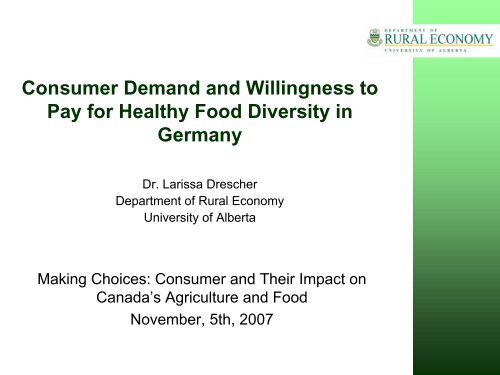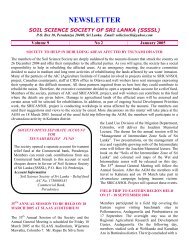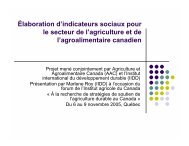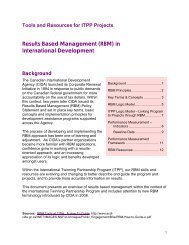Consumer Demand and Willingness to Pay for Healthy Food ...
Consumer Demand and Willingness to Pay for Healthy Food ...
Consumer Demand and Willingness to Pay for Healthy Food ...
You also want an ePaper? Increase the reach of your titles
YUMPU automatically turns print PDFs into web optimized ePapers that Google loves.
<strong>Consumer</strong> <strong>Dem<strong>and</strong></strong> <strong>and</strong> <strong>Willingness</strong> <strong>to</strong><strong>Pay</strong> <strong>for</strong> <strong>Healthy</strong> <strong>Food</strong> Diversity inGermanyDr. Larissa DrescherDepartment of Rural EconomyUniversity of AlbertaMaking Choices: <strong>Consumer</strong> <strong>and</strong> Their Impact onCanada’s Agriculture <strong>and</strong> <strong>Food</strong>November, 5th, 2007
Outline1. The impact of food diversity2. Measuring healthy food diversity- Traditional diversity measures- <strong>Healthy</strong> <strong>Food</strong> Diversity-Index (HFD-Index)3. Theory- <strong>Dem<strong>and</strong></strong> <strong>for</strong> healthy eating- <strong>Consumer</strong> Goods Characteristics Model (CGCM)4. Data & estimation5. Selected results- <strong>Dem<strong>and</strong></strong> analysis- <strong>Willingness</strong> <strong>to</strong> pay (WTP)6. Conclusions & Implications2
1. The impact of food diversity<strong>Food</strong> supply in the German retailer over timeNumber of food items14000120001000080006000400020000Supermarket<strong>Consumer</strong> marketDepartment s<strong>to</strong>resAverage1979 1991 1994 2000 2003YearEuroh<strong>and</strong>elsinstitut, several years3
1. The impact of food diversityPositive health aspects of food diversity- Assures supply with as many of 40 nutrients that arenecessary <strong>for</strong> survival (Royo-Bordonada et al., 2003)- Increases dietary quality (Hatloy et al., 1998)- Reduces probability of excessive contaminant intakefrom high amounts of any single food (Krebs-Smith etal., 1987)- Reduces morbidity: variety in vegetables decreasescancer risk about 36% (Jansen et al., 2004)- Decreases mortality risks: higher variety lowersmortality risk <strong>for</strong> all-sites cancer about 30% in women(Michels & Wolk, 2002)High diversity of plant foods: healthy food diversity4
1. The impact of food diversity<strong>Food</strong> guidelines- Advise food choices that promote health <strong>and</strong> decrease risk of chronicdiseases of all healthy people- Some differ across countries due <strong>to</strong> differences in food availablity,environment <strong>and</strong> eating patterns- But: diversity guideline almost always the first oneVariety message in USDA‘s guidelines over timeEdition YearWording1980-1999 Eat a variety of foods.2000 Let the pyramid guide your food choice. Choose a variety of grainsdaily, especially whole grains. Choose a variety of fruits <strong>and</strong>vegetables daily.2005 Consume a variety of nutrient-dense foods <strong>and</strong> beverages within<strong>and</strong> among the basic food groups while choosing foods that limitthe intake of saturated <strong>and</strong> trans fats, cholesterol, addedsugars, salt, <strong>and</strong> alcohol.5
1. The impact of food diversity- 1st of 10 guidelines of the German NutritionSociety (2005): “Enjoy the great variety of foods.Selection from among a great many different foods,appropriate combination <strong>and</strong> adequate quantities ofhigh-nutrient <strong>and</strong> low-energy food are characteristics ofa well-balanced diet“- Eating well with Canada‘s <strong>Food</strong> Guide (2007):„Enjoy a variety of foods from the four food groups.“6
2. Measuring healthy food diversityTraditional diversity measuresDistribution measuresn• Berry-Index BI = 1 − ∑Count Measures• Most frequently used• Number of foods or foodgroups• Disadvantages:– Equal weight <strong>for</strong>chocolate <strong>and</strong> apple– Distribution of foodsnot considered2s ii = 1• Number <strong>and</strong> distribution offoods• Disadvantages:– Equal weight <strong>for</strong>chocolate <strong>and</strong> apple– Diversity higher, themore foods are eatenin equal amountsCount measure = 250% 1% 50% 99%Berry – Index = 0,5 0,00997
2. Measuring healthy food diversity<strong>Healthy</strong> <strong>Food</strong> Diversity (HFD) - Index⎛ n ⎞ ⎛ n= ⎜ −21 ⎟ ⎜⎜ ∑si*⎟ ⎜∑hf⎝ i = 1 ⎠ ⎝ i = 1i* si⎞ s⎟ i= quantity share⎟⎠ hf i= health fac<strong>to</strong>rBerry-Index x health value= diversity (of the food basket)health fac<strong>to</strong>rs = hf i= describes the „value“ of single foods derived from the German food pyramide (German NutritionSociety)8
2. Measuring healthy food diversity<strong>Healthy</strong> <strong>Food</strong> Diversity – Indexqualitative dietary guidelines: pyramide sidesquantitative dietary guidelines: (modified) nutritioncircle 15 health fac<strong>to</strong>rs9
2. Measuring healthy food diversityShare of foodgroup(quantitativedietary guideline)Plant foods 73%Animal foods 25%Share of food sub group(qualitative guideline quantified)Vegetables/fruits/leaf salads/juices 36%Wholemeal products/paddy 28%Pota<strong>to</strong>es 20%White meal products/peeled rice 12%Snacks <strong>and</strong> sweets 4%Fish/low-fat meat/low-fat meat products 36%Low-fat milk, low-fat dairy products 28%Milk, dairy products 20%…Health fac<strong>to</strong>r0.73 *0.36 = 0.260.28 = 0.200.20 = 0.150.12 = 0.090.04 = 0.030.25 *0.36 = 0.090.28 = 0.070.20 = 0.05Fats & Oils 2& … …Health value = ∑health fac<strong>to</strong>r of food i * quantitative share of food i10
2. Measuring healthy food diversity• HFD-Index = Berry-Index x health value• Properties of HFD– Within health fac<strong>to</strong>r groups (eggs <strong>and</strong> meat)• increases with increasing number of foods eaten• Increases the more equally distributed the foods are– If the distribution between health fac<strong>to</strong>r groups (meat <strong>and</strong>apple) changes in favour of healthy (unhealthy) foodgroups:• HFD increases (decreases)• HFD-Index better reflects a healthy diet than traditionaldiversity measures (Drescher, Thiele, Mensink, 2007;Journal of Nutrition)11
3. Theory<strong>Dem<strong>and</strong></strong> <strong>for</strong> healthy eating<strong>Dem<strong>and</strong></strong> <strong>for</strong> Selected studies <strong>Dem<strong>and</strong></strong> theory CriticismNutrients<strong>Food</strong>sAbdulai <strong>and</strong> Aubert(2004)Brown <strong>and</strong>Schrader (1990)Lancaster‘scharacteristicsapproachTraditionaldem<strong>and</strong> theory<strong>Consumer</strong> don‘tdem<strong>and</strong> nutrients;confounder problemIncomplele picture ofthe diet; confounderproblemDietary quality(nutrients)Thiele et al. (2004) No reference <strong>Consumer</strong> don‘tdem<strong>and</strong> nutrients;confounder problemDietary quality(<strong>Healthy</strong>Eating-Index)Variyam et al.(1998)Lancaster‘scharacteristicsapproach<strong>Consumer</strong> don‘tdem<strong>and</strong> nutrients;confounder problem Complete picture of the diet: utilization of the HFD-Index withinLancaster‘s characteristics approach12
3. Theory• Lancaster’s characteristics approach (1966; 1971):– Not goods but rather characteristics provide utility– Linear production technology = amount ofcharacteristics from the consumption of all products• <strong>Consumer</strong> Goods Characteristics Model (CGCM) extension of Lancaster’s model by Ladd <strong>and</strong>Suvannunt (1976)• Assumption of the CGCMA1) negative marginal utility of one or more characteristicsprovided that the sum of the marginal utility remainspositiveA2) common, not necessarily linear consumptiontechnologyA3) utility independent of the distribution of characteristicswithin the good• CGCM version suggested by Eastwood et al. (1986)13
3. Theory<strong>Consumer</strong> Goods Characteristcs Approach• “Health” is a utility providing good; produced by foodswith the following characteristics:– <strong>Healthy</strong> food diversity (HFD)– Other nutritional characteristics, e.g. Vitamin C (C j)• Production functions– <strong>Healthy</strong> food diversity (HFD) (non-linear)• Influenced by human capital (K) (Chern, 2003)• Common:HFD = g( q ,..., q ,K )1 nq i = quantity– Other nutritional characteristics (C j ) (linear)• Education is a proxy variable of nutritionalknowledge (Variyam et al., 1998)• Common:q i = quantityC = fj( q ,..., q ,K )1 n14
3. Theory<strong>Consumer</strong> Goods Characteristcs Approach• Representative utility functionU = U C( ( q q , K ),...,C ( q ,..., q , K) , HFD( q q , K)1 1,..., n m 1 n1,...,n• Budget restriction (1 st constraint)n∑i = 1piqi≤ YY= incomep i= price of good iq i= quantitiy of good i• Quantity restriction (2 nd constraint)Q=n∑i = 1q iQ = <strong>to</strong>tal quantity (food basket)15
3. Theory<strong>Consumer</strong> Goods Characteristcs Approach• Solving maximization problem with LagrangeL = U( C ( q ,..., q , K) ,..., C ( q ,... q , K) , HFD( q ,..., q K))⎛+ λ ⎜1⎜⎝n∑i = 11 1 nm 1 n1 n,qi⎞ ⎛− Q⎟+ λ ⎜ −⎟2 Y⎜⎠ ⎝n∑i = 1p q• First order condition (FOC)ii⎞⎟⎟⎠∂L∂qi=m∑j = 1∂U∂Cj∂Cj ∂U∂HFD* + * + λ1− λ2p∂q∂HFD∂qiii= 0• 2 ways of solving FOC:– Derivation of the dem<strong>and</strong> function <strong>for</strong> characteristicsHFD = dHFD( p ,Y,K)– Solving FOC <strong>for</strong> prices (p i) implicit prices <strong>for</strong> thecharacteristics willingness <strong>to</strong> pay (WTP)nm∑p ⎜iqi= ∑βjCj + βHFD∑i = 1 j = 1i = 1⎛⎜⎝n∂HFD∂qi⎞* q ⎟i + β Q⎟0⎠16
4. Data & estimation• German Nutrition Survey (1998): 4030 participants– Representative <strong>for</strong> Germany– 133 different foods• External price data: MADAKOM <strong>and</strong> ZMP• <strong>Dem<strong>and</strong></strong> analysis: multiple regression– Dependent variable: HFD-Index (logit trans<strong>for</strong>mation)– Independent variables: socioeconomic, attitude <strong>and</strong>knowledge variables– Endogeneity problem: two-stage least squares estimation• <strong>Willingness</strong> <strong>to</strong> pay: multiple regression– Dependent variable: expenditure per unit (Box-Coxtrans<strong>for</strong>med)– Independent variables:• (Instrumented) characteristics of the food basket (HFD,Vitamin C, Calcium, quantity approximated by calories)• Socioeconomic variables (Nerlove, 1995)17
5. Selected results<strong>Dem<strong>and</strong></strong> analysisHFD-Index(trans<strong>for</strong>med)Independent variables: Parameter t-valueConstant 0.0320 0.13Household income in DM/1000 0.010* 1.83Age (logarithm) 0.380***Low education level -0.112**High education level 0.059**3.79-2.742.46Supplement taker 0.064** 3.12Vegetarian 0.290*** 6.57Sportive activity 0.100*** 4.48Smoker -0.129*** -5.07R 2 0.175***,**,* significance level 1%, 5%, 10%18
5. Selected results<strong>Willingness</strong> <strong>to</strong> pay (WTP)Dependent variable: food expenditure per unitParameter Chi 2 -valueHFD’ 164.638*** 1016.25Caloric density 19.442*** 921.51Vitamin C- density 37.043*** 136.11Calcium – density -10.729*** 200.56Net equivalence income(DM/1000)-0.162*** 24.24Age -0.205*** 163.80Age 2 0.002*** 131.96Low education 0.218* 2.91High education -0.839*** 85.55Supplement taker -0.226** 10.87Smoker 1.080*** 168.78Vegetarian -2.488*** 263.58***,**,*significancelevel1%, 5%, 10%19
5. Selected results<strong>Willingness</strong> <strong>to</strong> payVariable Implicit prices ElasticitiesHFD’ 0.066 DM/HFD 1.721Caloric density 0.008 DM/kcal 2.397Vitamin C-density 0.015 DM/mg 0.298Calcium-density -0.004 DM/mg -0.46620
6. Conclusions & ImplicationsLinking the results:• Higher income:- <strong>Dem<strong>and</strong></strong> <strong>for</strong> HFD ↑, food expenditures per unit ↓- No significant interaction effect between HFD <strong>and</strong> income onfood expenditure per unit High-income consumers are more efficient in selecting a goodquality with less costly foods• Higher education- <strong>Dem<strong>and</strong></strong> <strong>for</strong> HFD ↑, food expenditures per unit ↓- If low-educated consumers dem<strong>and</strong> HFD of higher quality:food expenditures per unit would be higher Low-educated consumers are less efficient in food dem<strong>and</strong>• Positive attitudes <strong>to</strong>wards health– Vegetarians, supplement takers <strong>and</strong> nonsmokers have ahigher dem<strong>and</strong> <strong>for</strong> HFD but lower food expenditure per unit A positive attitude <strong>to</strong>wards health enables <strong>to</strong> obtain HFD withless costly foods21
6. Conclusions & ImplicationsImplications <strong>for</strong> German nutrition <strong>and</strong> health policy• Dietary in<strong>for</strong>mation actions geared at consumers– With lowest education level– Who already reveal undesired health behavior (e.g.smoking)– Younger consumers• Public health strategies– To increase awareness of HFD <strong>and</strong> <strong>to</strong> establishincentives that sustain consumer’s self responsibility <strong>for</strong>health– To support changes in dietary behavior in favor of morenutrient- but less energy-dense diets• Communicate how <strong>to</strong> obtain healthier diets with less costlyfood items22
THANK YOU FOR YOUR ATTENTION!23
3. Theory<strong>Consumer</strong> Goods Characteristcs Approach• Derivation of dem<strong>and</strong> functions– Solving <strong>for</strong> optimal quantities of the characteristics byusing the implicit function theorem– <strong>Dem<strong>and</strong></strong> function <strong>for</strong> <strong>Healthy</strong> <strong>Food</strong> Diversity:HFD=Cdj =HFDdj( p ,Y,K)– <strong>Dem<strong>and</strong></strong> function <strong>for</strong> other nutritional characteristics( p ,Y,K)• Derivation of implicit pricespi⎛ m1 ⎜ ∂U=λ ⎜∑2 ∂C⎝ j = 1 j*∂C∂qij+∂U∂HFD*∂HFD∂qi⎞+ λ ⎟1⎟⎠24
3. Theory<strong>Consumer</strong> Goods Characteristcs ApproachDerivation of implicit prices• Assumptions:– λ 1 = marginal utility of the <strong>to</strong>tal quantity of foodsconsumed (assumed <strong>to</strong> be constant)– λ 2 = marginal utility of income (Ladd <strong>and</strong> Suvannunt,1976; Eastwood et al., 1986)• With respect <strong>to</strong> the budget constraint, Y is replaced byexpenditure (E)• Hedonic price equationpi=m∑j = 1∂C∂qij∂E∂Cj∂HFD+∂qi∂E∂HFD∂E+∂QMarginal rate of substitution of consumer‘s Implicit price expenditure <strong>for</strong> <strong>to</strong>tal <strong>for</strong> quantity each HFD of theothe implicit rnutritional price <strong>for</strong> characteristics one additional unit marignal HFD implicit price <strong>for</strong> an additionalunit of characteristic j25
3. Theory<strong>Consumer</strong> Goods Characteristcs Approach• Empirically estimable hedonic price equationpi=m∑j = 1β cjji+ βHFD∂HFD∂qi+β 0• Prices of homogenous food products are similaramong consumers <strong>and</strong> do not vary substantially multiplication by q inm∑p ⎜iqi= ∑βjCj + βHFD∑i = 1 j = 1i = 1⎛⎜⎝n∂HFD∂qi⎞* q ⎟i + β Q⎟0⎠• Assumption of constant implicit prices not consistent<strong>for</strong> a unique maximum (Morse <strong>and</strong> Eastwood, 1989) variable implicit prices: Box-Cox trans<strong>for</strong>mation26
6. Summary & Conclusions• <strong>Dem<strong>and</strong></strong> <strong>for</strong> HFD positively influenced by– Income– Education– Positive attitudes <strong>to</strong>wards health• WTP <strong>for</strong> healthy food diversity– Highly significant WTP <strong>for</strong> HFD (0.66DM/HFD)– WTP <strong>for</strong> caloric density is higher than <strong>for</strong> HFD– Participants with• high income• high education• positive health attitudes have lower food expenditures per unit compared <strong>to</strong>their counterparts27
















